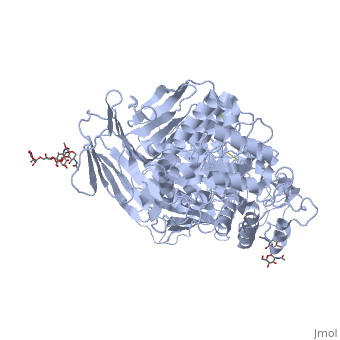Sucrase-isomaltase
From Proteopedia
FunctionSucrase isomaltase (SI) is a partially embedded integral protein located in the brush border of the small intestine. SI is responsible for catalyzing the hydrolysis of dietary carbohydrates that includes starch, sucrose, and isomaltase. This hydrolysis leads to ATP production after further processing. The brush border is important for the functional absorption of minerals and amino acids so the body can properly use them. The border is composed of millions of microvilli tightly packed together that are anywhere from 100 to 2,000 nanometers. Absorption is effective at a location such as this due to the large surface area being open for contact. [1] Some other key enzymes that capitalize on this characteristic in the small intestine are: glucoamylase (Maltase), lactase, and peptidases. Among these common enzymes however is SI, which is important because it is critically involved in the final stage of carbohydrate digestion. [2] Specifically, this enzyme works by catalyzing the conversion of isomaltose into glucose molecules. Cleaving bonds with water (hydrolysis), SI interacts with glucosidic linkages produced by alpha-amylase. [3] StructureSucrase isomaltase is classified as a glucosidase enzyme due to its role in creating monomers from larger complex carbohydrates. SI is composed of two subunits: sucrase and isomaltase. These two subunits come from a polypeptide, having an N-Terminus and a C-Terminus. Via heterodimerization, the sucrase isomaltase complex is formed [4]. The protein becomes glycosylated to attach to the apical membrane. [5] The N-terminus side of the isomaltase subunit anchors the protein to the cell membrane via hydrophobic interactions. [6] According to research, both carboxylate and carboxyl groups have been found in to be essential parts of the catalytic mechanism of sucrase isomaltase. Both have been found to be located within each of the active sites of the complex. [7] Within sucrase-isomaltase an active site-directed inhibitor called conduritol-B-epoxide is able to irreversibly inactivate each of the subunits at different rates. It has been suggested that this inhibitor then eventually remains bound to the carboxylate found in the the active site of the subunits via an ester bond. The groups that react with this inhibitor are likely to be responsible for sucrase-isomaltase’s catalytic mechanism by stabilizing the ion responsible for the complex’s rate-limiting step.[8]
Medical ImplicationsCongenital Sucrase-isomaltase Deficiency is a mutation in the sucrase isomaltase gene and it affects individuals ability to digest sugars such as sucrose and maltose. Genetically speaking, SID is an autosomally recessive intestinal disorder. Due to its equal presence in males and females, and the skipping of generations in which it is inherited, it is concluded that the disease is not linked to a sex chromosome nor expressed dominantly. The disease begins to take shape and show signs in late infancy/early childhood when different types of foods are ingested for the first time. This includes various fruits and grains that would involve carbohydrate breakdown in the body. Mutations cause the enzyme activity to be greatly reduced or completely absent. Symptoms of SID include severe intestinal pain, diarrhea, abdominal pain, and cramps when sugar is ingested. [9] Some known mutations that cause the disease: Q117R Missorts the enzyme to the basolateral membrane L341P mutates the anchor causing the enzyme to become unattached from the membrane L620P the SI unit accumulates predominantly in the Endoplasmic reticulum Q1098P causes intracellular accumulation of mannose-rich SI in the Golgi C1229Y/F1745C cause sucrase domain membrane blockage (folding unaffected) Structural highlights-Sucrase-isomaltase is a monomer that is dependent upon experimental conditions in terms of structure. -The four monomers form the asymmetric unit and have identical active sites. -The active sites are composed of shallow-substrate binding pockets. The non-reducing end of substrates binds to a pocket. The sugar component has interactions with the inner subset, and the reduced component interacts with the superficial subsite. [10] -The gene on which SI processes occur is located on chromosome 3 and is composed of 48 exons. |
| |||||||||||
References
- ↑ http://www.siumed.edu/~dking2/erg/gicells.htm
- ↑ http://www.uniprot.org/uniprot/P14410
- ↑ Maureen Barlow Pugh, ed. (2000). Stedman's Medical Dictionary (27th ed.). Baltimore, Maryland, USA: Lippincott Williams & Wilkins. p. 65. ISBN 978-0-683-40007-6.
- ↑ "SI sucrase-isomaltase (alpha-glucosidase) [Homo sapiens (human)] - Gene - NCBI"
- ↑ Naim HY, Sterchi EE, Lentze MJ (1988). "Biosynthesis of the human sucrase-isomaltase complex. Differential O-glycosylation of the sucrase subunit correlates with its position within the enzyme complex". J. Biol. Chem. 263 (15): 7242–53. PMID 3366777
- ↑ http://www.jbc.org/content/254/6/1821.full.pdf
- ↑ http://onlinelibrary.wiley.com/doi/10.1111/j.1432-1033.1977.tb11335.x/epdf
- ↑ http://www.jbc.org/content/251/11/3250.full.pdf
- ↑ http://www.iffgd.org/site/gi-disorders/other/csid
- ↑ Sim L, Willemsma C, Mohan S, Naim HY, Pinto BM, Rose DR (2010). "Structural basis for substrate selectivity in human maltase-glucoamylase and sucrase-isomaltase N-terminal domains". J. Biol. Chem. 285 (23): 17763–70. doi:10.1074/jbc.M109.078980. PMC 2878540. PMID 20356844

